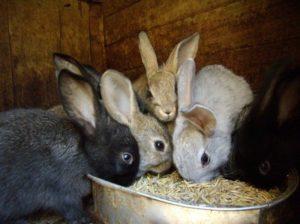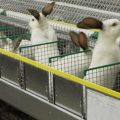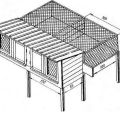Description and characteristics of French ram rabbits, care for them
Rabbit breeding is fun and profitable. Animal breeding has been going on for centuries. Large animals with valuable fur are especially popular with rabbit breeders. The French ram is a breed of rabbits with drooping ears, known since the 19th century. Rabbits of this breed have a lot of advantages, they are appreciated by farmers for their large size, high-quality fur, good disposition, ease of care and cute appearance.
History of the breed
Breeding work on breeding the breed began in 1850. Defective rabbits with saggy ears (mutation of the auricle) became the inspiration for obtaining a new species. A certain Condenier crossed between English rams (a breed of rabbits) and Rouen giant rabbits.
As a result of the work, the breeders managed to consolidate the desired properties, to obtain animals with drooping long ears, a large body, and a delicate durable skin. The rabbits had a benevolent disposition, grew quickly, and bred regularly.
Due to their obvious advantages, the animals quickly spread throughout Europe, served as the basis for the selection of many fold-eared rabbits in Germany and Holland. The French ram received official recognition in 1922.
Characteristics and standard, features
The appearance of a French ram, according to breed standards, has the following characteristics:
- weight - 4-7 kilograms, large individuals reach 10 kilograms, males are somewhat smaller than females;
- body - elongated, 60-70 centimeters;
- fur color - different is allowed, including a combination (2-3 colors);
- the structure of the fur is soft and silky, with a pronounced dense undercoat;
- the shape of the head resembles a ram - with a pronounced frontal bone and shortened hair, the cheeks are plump and overweight;
- famous ears grow up to 20-40 centimeters, drop a few centimeters below the chin of a rabbit, width - 10-15 centimeters;
- the hind legs are powerful and elongated, the front legs are traditionally short;
- croup - wide, rounded.

Reference: the ears of rabbits fall at the age of one and a half to two months, at birth, lop-earedness is invisible.
Breeders appreciate rams for their non-conflict nature, phlegm. Defects of the auricle make rabbits deaf, so they do not react much to noise, do not shake from extraneous sounds, do not fuss for no reason.
To avoid problems with reproduction in this breed, you need to monitor the diet, since the French ram is prone to obesity, and this reduces the already low fertility. Rabbits of this breed become attached to their owners, love affection, appreciate the care and society of a person.
Pros and cons
The advantages of the breed include:
- fast weight gain, which characterizes the breed as highly productive, at the age of three months a rabbit can be slaughtered
- high-quality fur of various colors;
- friendly disposition, non-aggressive character;
- eat any food - do not require special diets.

Animals are loved for their funny appearance, pleasant to the touch skin, which you just want to stroke.
The breed has a lot of disadvantages:
- frequent illnesses due to low immunity;
- low, in comparison with other breeds, fertility, which is caused by a decrease in sexual functions due to high weight;
- increased area for content;
- special insulation of premises.
French rams suffer from gluttony (especially babies), due to overeating and endocrine problems they reproduce even worse.
Breed types
After the appearance of the French ram, active selection of fold-eared rabbits began. Several breeds of rams have been bred:
- English. A short-haired rabbit with dense fur and elongated ears, which prevent the animal from walking, lie on the ground.
- Meissen. Weight - 3-5 kilograms, heavily pubescent ears. Cultivated in Germany, the number of representatives of the breed is constantly decreasing, the species is on the verge of extinction.
- Dwarf. A group of decorative species with hanging ears, beautiful fur, calm character. Weight - 1.5-2 kilograms.
- Dutch. Small animals (1.2-1.8 kilograms) are bred as decorative ones.
- German. A meat breed of a rabbit weighing up to 9 kilograms.

The velveteen fold breed is in its infancy, the standards are still being formed.
How to properly maintain and care for
For a comfortable life, a ram will need a larger cage than for regular rabbits. A large animal must have room for free movement. The following cage sizes are recommended:
- 100x90 centimeters, height - 70-80 centimeters;
- for pregnant females - 120x90 centimeters, height - 80 centimeters.
It is best to keep animals in enclosures whenever possible. Females and males are kept separately, settling up to 3 individuals together. It is better not to use cages made of mesh materials, as animals are prone to poddermatitis.
Content recommendations:
- The floor of the cage is made smooth (boards), with a slight slope.
- They put rabbit houses in corners, closed from drafts and direct sun.
- The floor is lined with hay or sawdust.
- Maintain temperature 18-23 °, humidity - 50-75%. Sheep are thermophilic animals, they put heaters in winter, not allowing the air to drop below 10 °.
- Feeders and drinkers made of metal or other material that cannot be nibbled are attached to the cage (to the wall). It is better to raise them above the floor so that your ears do not get dirty or wet.
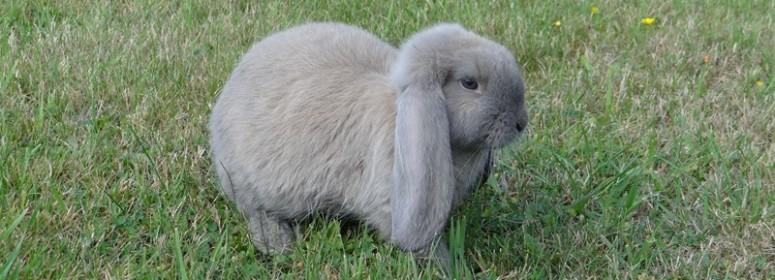
The cages are regularly cleaned, litter changed, old food and feces removed. Once every few months, disinfection is carried out, thoroughly soaked with bleach, kept for several hours, then washed.
How to feed a French ram
The French ram can chew all the time while it is awake. Feed must be dosed, dispensed 3 times a day, calculating portions. This breed quickly builds up fat at the expense of muscle mass.
The diet includes:
- summer - grass dried for several hours (burdock, dandelion, clover, nettle);
- hay - no signs of rot, dry, from various herbs;
- cereals - mainly oats and wheat;
- vegetables - carrots, beets, cucumbers;
- fruits (apples, pears);
- melons;
- in winter - compound feed.
Tomatoes, legumes, rhubarb should be excluded from the diet. In winter, hay and mixed feed are supplemented with vegetables so that the rams can crunch juicy fruits. Twigs of trees, crackers help to satisfy the thirst for chewing.

The completeness of the winter diet is supported by vitamin complexes with micro and macro elements.If vegetables and fruits are not available, premixes for rabbits can be added to the feed. Small amounts are given chalk and salt. They give rabbits to drink with warm water; it is convenient to use nipple drinkers.
Breeding features
Females reach sexual maturity at 9 months, males at 5-6 months. For mating, the best representatives of the breed are chosen, trying to exclude a close relationship. Rabbits must be healthy, meet standards, and not be overweight.
The female is provided with a spacious cage, enhanced nutrition during pregnancy and feeding. Bearing lasts about a month, 5-8 rabbits are born (rarely 10-12).
Female rams are famous for their developed maternal instinct, take care of babies, do not eat, and patiently feed everyone. The first round is planned while the female is not a year old; at 3 years old, mating is stopped due to possible complications.
The life expectancy of representatives of the breed reaches 10 years. At 3-4 months in rabbits, rams are slaughtered, the meat is famous for its taste and dietary qualities, tender and juicy. The yield of meat products is up to 60% of the rabbit's weight.
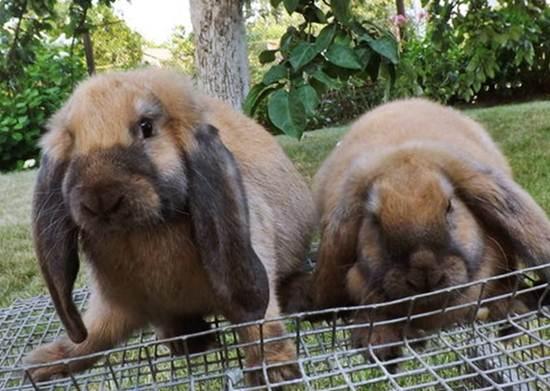
Diseases and prevention
The French ram does not differ in strong immunity. The most common health problems in rabbits of this breed include:
- gastrointestinal diseases;
- infections;
- diseases of the soft parts of the paws - corns, ulcers (pododermatitis);
- colds;
- ear injuries with improperly organized space.
Vaccinations (including from myxomatosis), carried out at the recommended time, help to avoid many infections. Replacing the litter in a timely manner and keeping the indoor warm and humid will protect rabbits from infections and colds. The floor of the cage is made of smooth materials (do not use fleecy and mesh) to prevent pododermatitis.

Important: they begin to vaccinate rabbits at the age of one and a half months, this ensures the full growth and development of young animals, weight gain, and supports productivity.
Where to buy young rabbits of this breed?
Domestic rabbit breeders consider the high cost to be a disadvantage of the breed. The price of purebred young animals of European selection reaches several thousand rubles. You can buy a rabbit from simple manufacturers for 500-1000 rubles.
When buying, you need to focus on the reputation of the farm, check genealogical data, compliance with breed standards, and the availability of vaccinations. Purebred animals must have provenance documents.
Note that it is more profitable to breed other breeds of rabbits that are more productive than the French sheep.
Rabbits are raised for meat and skins, and many keep animals as pets. The French ram is distinguished by its easygoing character, therefore it is excellent as a companion. Having mastered the rules of care and maintenance, you can breed the breed for commercial purposes and to get delicious homemade meat.

